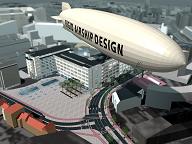|
|
BIGGER THEN BIG...
Imagine an aircraft 180 metres long. When you have mentally put together 3 football
pitches and put the idea aside as fantastic, now consider that it is capable of an
endurance of weeks, has global reach and is in every sense environmentally friendly.
This may sound incredible, but it has all been done before.
For further information click
AIRSHIP PHOTO
|
When Ian Alexander launched the 'Revival of Classic Rigid Airships' in 1996,
EEC Events immediately became enthusiastic about the idea. As a professional 'Imaginator'the company was
able to translate ship-loads of information into 5 page understandable language for the
common man. From then on, EEC Events became in charge of Media Affairs and promotion-activities regarding the
realisation of the 'Rigid Airship Project'. Although the Rigid Airship Design company went bankrupt, the
basic idea remains feasible. An airship of such magnitude would be an ideal solution to transport goods and
aid into disaster areas in Africa but also outside.

Holland Navigator B.V. (i.o.) is a Dutch marketing entity formed by Hoogeweegen Taskforce B.V.and EEC Events B.V.
This company developed a unique concept to organise an around the world maiden voyage with the first rigid airship
to be build. The Holland Navigator project aimed to have landings at 15 selected places on all continents of the
world. A 'maiden voyage' offers enormous opportunities for worldwide Promotion, Global Publicity and exposure
for its sponsors. The name of this airship would have been:

'REVIVAL OF THE GIANTS'
 RetroGiant over New York
RetroGiant over New York
 Graf Zeppelin over the Alps
Graf Zeppelin over the Alps
|
By the start of the Great War the airship had been developed into two main types
- rigid and non-rigid (technically, the latter is more accurately described as pressurerigid).
Cylindrical in cross-section, both were given buoyancy by gas and motion by engine-driven
propellers and were controlled by vertical rudders and horizontal elevators. In the rigid type,
a solid framework, which might be likened to a skeleton, supports an external covering of fabric
called the envelope (a very few experimental types had a metallic covering). Within the framework
are contained bags of gas called balloonets. In the non-rigid, the envelope's shape is maintained
by the pressure of the gas that fills it; there is no framework.The rigid's control car and
engines are suspended from the framework. in the non-rigid they are attached directly to or
suspended directly from the envelope. In some later rigids the engines were mounted
internally, driving the propellers by transmission belts.
|
|


 RetroGiant over New York
RetroGiant over New York
 Graf Zeppelin over the Alps
Graf Zeppelin over the Alps